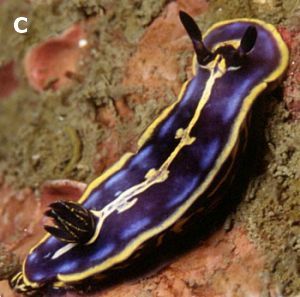
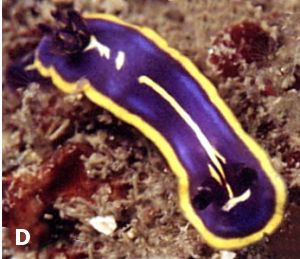
Hypselodoris fontandraui
(Pruvot-Fol, 1951)
Order: NUDIBRANCHIA
Suborder: DORIDINA
Superfamily: EUDORIDOIDEA
Family: Chromodorididae
DISTRIBUTION
Western Mediterranean and nearby Atlantic Coast of Spain, Azores.
PHOTO
C. size 20 mm; Depth 10 m; Punta del Vapor (Almuñecar) Granada, Spain. 23 January 1999. D. size 30 mm; depth 11 m; (Almuñecar) Granada, Spain. 29 April 1998.
PHOTOS: Luis Sánchez Tocino
Reference:
• Ortea, J., Valdés, A. & García-Gómez, J.C. (1996) Revisión de las especies atlánticas de la familia Chromodorididae (Mollusca: Nudibranchia) de grupo cromático azul. [Review of the Atlantic species of the family Chromodorididae (Mollusca: Nudibranchia) of the blue chromatic group.] Avicennia, 1996, Suppl. 1: 1-165.
Rudman, W.B., 2001 (October 5) Hypselodoris fontandraui (Pruvot-Fol, 1951). [In] Sea Slug Forum. Australian Museum, Sydney. Available from http://www.seaslugforum.net/find/hypsfont
Related messages
Re: Hypselodoris fontandraui feeding
September 9, 2009
From: Marc Bosch Mateu
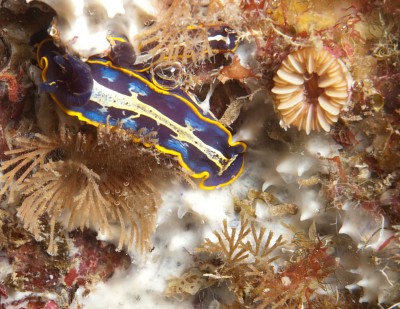
Concerning message #22637:
Hi Bill,
Here are three photos of Hypselodoris fontandraui feeding on Dysidea avara as you asked.
Locality: Far de Sarnella, Costa Brava, 20 metres, Catalunya,, Mediterranean, 15 july 2009, Pre-coraligen. Length: 10 mm. Photographer: Marc Bosch Mateu.
Glad to participate
Marc
http://entitu.blogspot.com/
http://www.flickr.com/photos/27427048@N08/
entitu@gmail.com
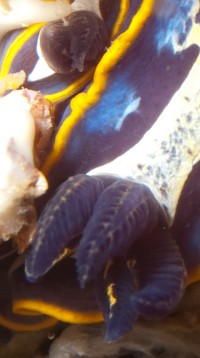
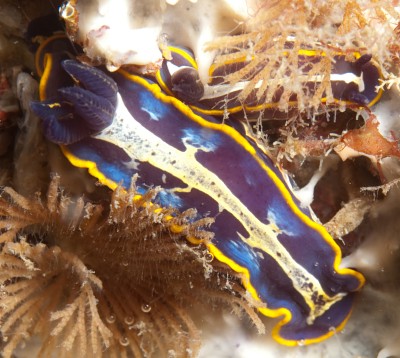
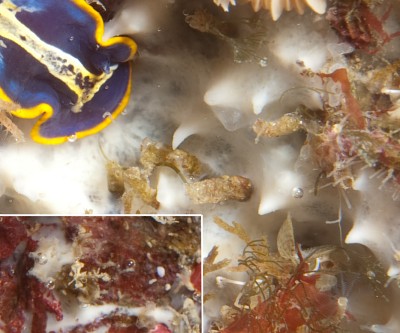
Dear Marc,
Apart from your photos being another good record of the nudibranch feeding on this white species of Dysidea, it is also gives us a look at another colour form of Hypselodoris fontandraui.
If I had seen just the large animal with its broad median whitish band, I would have suspected this was H. bilineata, but in the small animal alongside we can see that the median 'white' line shows signs of widening near the gills. It certainly makes me wonder if H. bilineata is just a colour form of H. fontandraui.
Best wishes,
Bill Rudman
Hypselodoris fontandraui feeding
September 4, 2009
From: Antoni López-Arenas i Cama

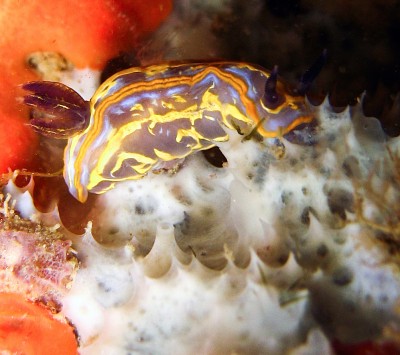
Concerning message #22637:
Hi Bill,
Here are a pair of photos of Hypselodoris fontandraui feeding on Dysidea avara as you asked.
Locality: Cala d'Aiguafreda, Begur, Costa Brava., 19 metres, Spain, Mediterranean, 29 June 2008, Rocky wall. Length: 20 - 30 mm. Photographer: Antoni López-Arenas i Cama.
Glad to participate
Antoni
http://bitxosdelmediterrani.blogspot.com
http://www.flickr.com/photos/alopezarenas/sets/72157603891082971/
alopezarenas@gmail.com
López-Arenas, A., 2009 (Sep 4) Hypselodoris fontandraui feeding. [Message in] Sea Slug Forum. Australian Museum, Sydney. Available from http://www.seaslugforum.net/find/22640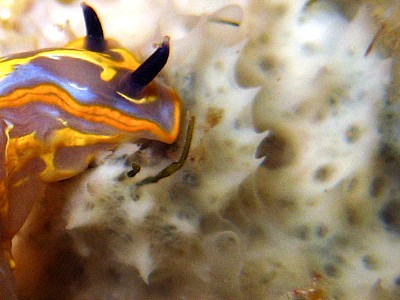
Dear Antoni,
Thanks very much. As I said previously [#16948 ], I am not sure if this sponge is Dysidea avara. Interestingly, the only other records we have of H. fontandraui are on this whitish sponge. In comparison, the pinkish sponge - which seems typical of Dysidea avara - is usually associated with Hypselodoris tricolor [see your message #22641].
Best wishes,
Bill Rudman
Hypselodoris fontandraui mating
September 3, 2009
From: Antoni López-Arenas i Cama
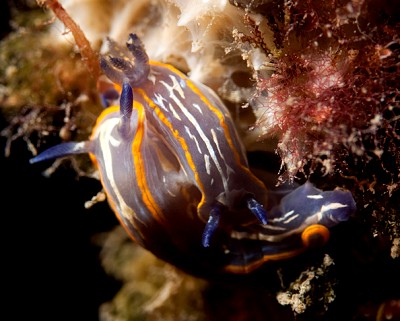
Concerning message #5523:
Dear Bill,
Here goes a pair of voyeur photos of Hypselodoris fontandraui mating.
Locality: Formigues islands, Costa Brava., 25 metres, Spain, Mediterranean, 15 August 2009, rocky wall. Length: 1 cm aprox. Photographer: Antoni Lopez-Arenas i Cama.
Regards,
Antoni Lopez-Arenas i Cama.
http://bitxosdelmediterrani.blogspot.com
http://www.flickr.com/photos/alopezarenas/sets/72157603891082971/
alopezarenas@gmail.com
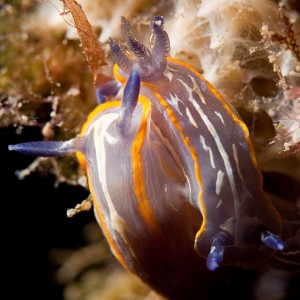
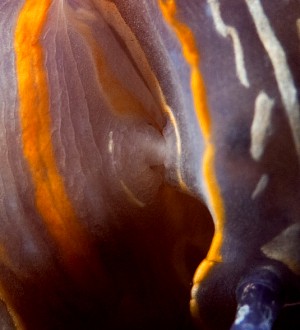
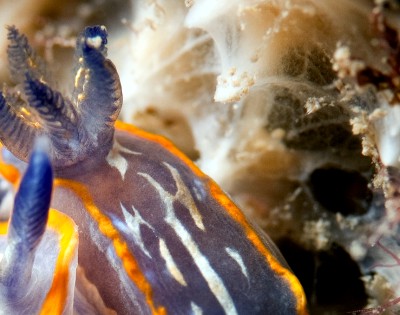
Dear Antoni,
Thanks for these photos. As you no doubt realise there still seem to be difficulties in distinguishing some of the blue species of Hypselodoris from each other, in your part of the world. Photos of mating pairs can be quite useful in determining colour pattern variability within species.
Another thing that greatly interested me in your photos was the sponge in the background which is clearly a species of Dysidea. As I am trying to build up a fuller picture of feeding specificity in this family, every new bit of information is valuable. Looking at you flickr pages I see a couple more sponge associations which would be nice to include on the Forum.
As I discuss in an earlier message [#16948] I am not sure if this whitish sponge is Dysidea avara which is usually a pinkish colour with a more compact fibrous network. Perhaps it is a form of D. fragilis? Whatever its identity, it is good to get confirmation that another species of Hypselodoris is feeding on a dysideid sponge.
Best wishes,
Bill Rudman
Hypselodoris fontandraui from Portugal
April 24, 2008
From: Joao Pedro Silva
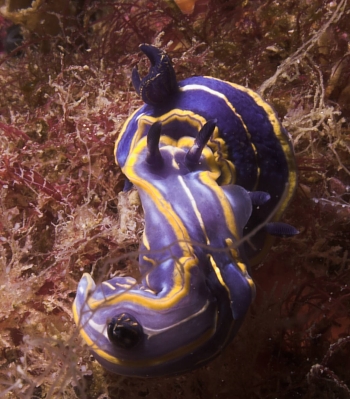
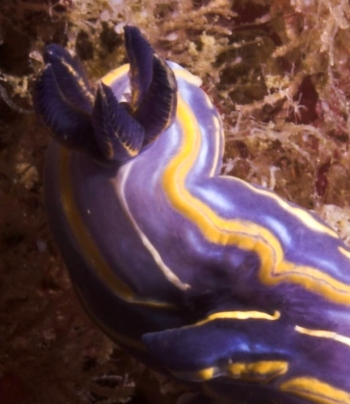
Dear Bill,
Using Marina Poddubetskaia's table [message #11220] I've tentatively identified these two as Hypselodoris tricolor. One of the individuals appears to have suffered some harm on the mantle.
Locality: Sesimbra, 25m, Portugal, North Atlantic, 19 September 2007, Rocky bottom. Length: 3cm. Photographer: Joao Pedro Silva.
Cheers,
Joao Pedro
jpsilva@uwphotographer.net
Silva, J. P., 2008 (Apr 24) Hypselodoris fontandraui from Portugal. [Message in] Sea Slug Forum. Australian Museum, Sydney. Available from http://www.seaslugforum.net/find/20801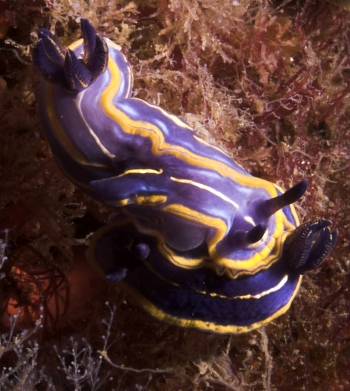
Dear Joao Pedro,
Although I hesitate to identify the notorious 'blue chromodorids' of your region, I am pretty sure these are Hypselodoris fontandraui. Marina's table is quite a good guide but you could be misled by her table saying H. tricolor has one median yellow line on the mantle and H. fontandraui has a white one when in fact both species seem to vary in that character. However her description of the gill colour is correct, H. tricolor having one yellowish line on the outside while H. fontandraui has one inner yellow line and two outer lines. You can see these lines quite clearly in the middle photo, which is a close-up. It also shows the tear in the mantle which looks as though it is the result of some physical damage.
Best wishes,
Bill Rudman
Hypselodoris fontandraui from sthn Portugal
February 13, 2008
From: Pedro Filipe Veiga
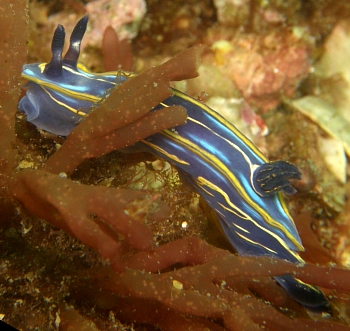
Dear Bill,
Here are some photos of a sea slug specimen that was observed in August 2007 near the locality of Albufeira (Algarve, South of Portugal). I think is an Hypselodoris fontandraui. Could you confirm this identification?
Locality: In front of Albufeira around 15 metres, Atlantic Ocean, 14 August 2007, found near the bottom (gravel kind). Length: Around 25 mm. Photographer: Pedro Veiga.
Looking forward to hear from you,
Best regards,
Pedro
P.S. Project RENSUB II: CCMAR-CCDRALG-DRAOTA: "Cartography and characterization of the marine communities off the National Underwater Ecological Reserve between Galé and Ancão"
FCMA/CCMAR
Universidade do Algarve
Campus de Gambelas
8005-139 Faro,
Algarve, Portugal
pveiga@ualg.pt
Veiga, P., 2008 (Feb 13) Hypselodoris fontandraui from sthn Portugal. [Message in] Sea Slug Forum. Australian Museum, Sydney. Available from http://www.seaslugforum.net/find/21299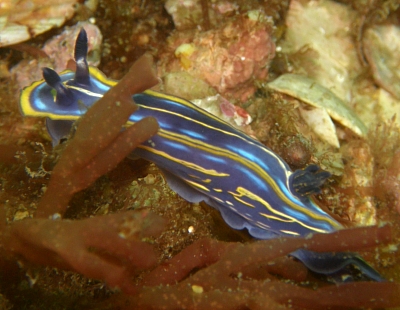
Dear Pedro,
The 'blue chromodorids' from your part of the world are quite tricky so I can't be 100% sure that I am correct, but I would agree with your identification of this as H. fontandraui. The white patch of the back of the rhinophore stalk and the secondary yellow lines running at an angle from the median line down each side of the body/foot seem to be good characters differentiating this from similarly coloured species.
Best wishes,
Bill Rudman
Hypselodoris fontandraui ? from mediterranean France
August 6, 2007
From: Laurent Urios
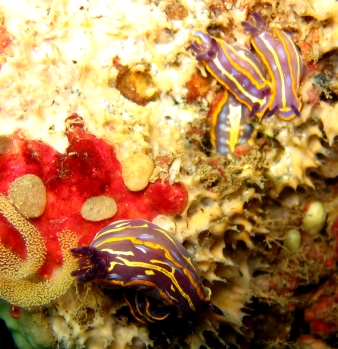
Hi !
I took these pics last month near Collioure (France - Mediterranean Sea) at 10 m depth. I'm sorry for the bad quality. Can you tell me if all are Hypselodoris fontandraui? I have doubts because of the smallest ones that have points along the line that makes me think of H. tricolor. And concerning the lonely one on the other photo, the pattern doesn't seem to be like the ones I have seen in books and on your website (congratulations for this great source of information !).
Locality: Collioure, 10 m, France, Mediterranean Sea, 12 June 2007, rocky coast. Length: between 2 and 3 cm. Photographer: Laurent Urios.
Thank you.
Laurent.
homo_palmus@yahoo.fr
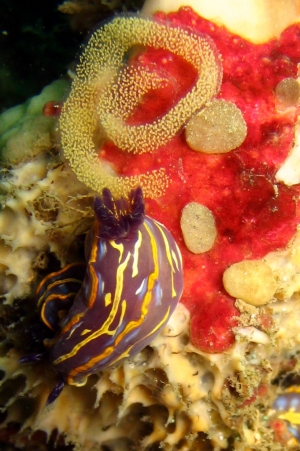
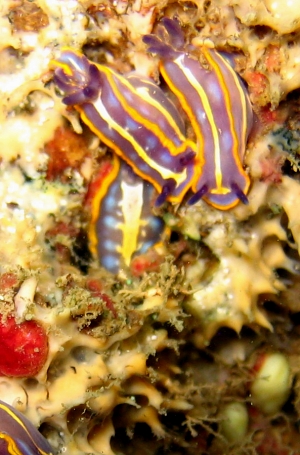
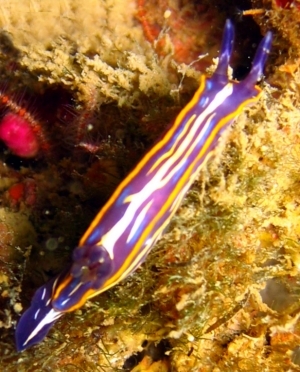
Dear Laurent,
I am pretty sure these are all Hypselodoris fontandraui. They seem to be feeding on the dirty yellow sponge which has bundles of fibres sticking out of conical outgrowths on the colony. This species is reported to feed on Dysidea avara, which looks nothing like this. It is possibly a dying colony but I will have to check with a sponge expert. The egg ribbon is rather tantalising but its not possible to say if these slugs are responsible for it.
Best wishes,
Bill Rudman
Re: Hypselodoris fontandraui from Cannes
June 26, 2006
From: Dominique Horst
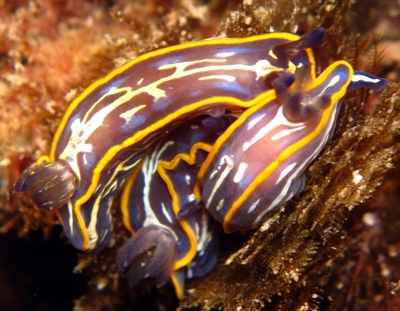
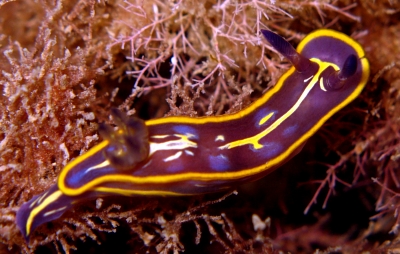
Concerning message #16844:
Hi Bill,
I've identified the following as again H.fontandraui. I guess you will confirm this.
Locality: Cap d'Antibes, 13m, France, Mediterranean sea, 21 June 2006, vertical rock. Length: 20mm. Photographer: Dominique Horst.
Looking at all the pictures I've have now of this dorid, I am surprised at the variability of this species especially the patterns and colors. Sizes of these all were very different so I assume that their respective sizes are related to their ages. Have you any idea on how long these dorid live ?
Also, is their variability related to their age ? That is, do their colour patterns change a lot during their life ? And also, is their variation in colour pattern between male and female ?
Thanks in advance,
Kind regards,
Dominique
dominique.horst@wanadoo.fr
Horst, D., 2006 (Jun 26) Re: Hypselodoris fontandraui from Cannes. [Message in] Sea Slug Forum. Australian Museum, Sydney. Available from http://www.seaslugforum.net/find/16953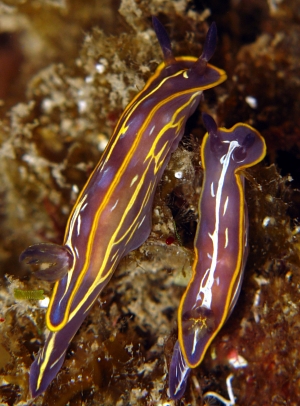
Dear Dominique,
I will start with your last question first, because it has an easy answer. All sea slugs are hermaphrodite, that is they have full functional male and female reproductive systems, so there can be no gender differences in colour pattern.
Concerning age and colour patterns, there are certainly obvious differences in very small juveniles in which colour pigmentation is first appearing, but once that stage is past most species can be recognised by their colour pattern, even if there are some differences between young and adult animals. In many species we just don't have enough observations to say whethre there are distinct 'adult' and 'juvenile' colour forms. From what I can read about H. fontandraui, there seems to be some differences between juveniles and adults, with juveniles having a darker blue background colour and the median line between the rhinophores and the gills being white rather than yellow. However the many other differences you and others have illustrated don't seem to be age-related.
However if you regularly visit a place where there is a fairly constant population of the species, it would be fairly easy for you to study this very question. All you would need to do is regularly take photos of animals of varying sizes for a few months and see if there is any correlation between colour, colour pattern and length. The simplest way to record the length of your animals would be to take a small centimeter scale with you and put it alongside the animals you are photographing. With luck you could tell us, with photographic proof, the answer to your own question.
I almost forgot your question about how long they live? Again, for most species we don't know, but from the species we do know, the general belief is that most nudibranchs live for less than one year, although some live for only a few weeks and others for four of five years. Following life cycles is quite difficult and in animals such as chromodorids, which are dependent on a particular species of sponge for food, the life cyccle of the sponge is also an important factor. Some species of sponges are short-lived and others apparently live for some years, but again our knowledge of sponge natural history is as poor as our knowledge of nudibranch natural history - the ones we know about are considered to be 'typical examples' when in fact they may be strange exceptions.
Best wishes,
Bill Rudman
Hypselodoris fontandraui - strange behaviour
June 24, 2006
From: David Abecasis
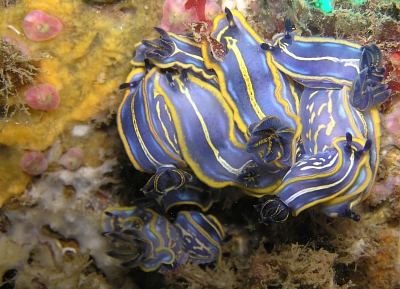
Hi Bill,
Although I've already seen some nudis together I have never seen anything like this. Probably there is more than one species present. Unfortunately the place wasn't every easily acessible so I couldn't be sure of what they were doing or of how many individuals there were. Besides the photos I'm sending I also have some more of some individuals alone.
Locality: Albufeira, 17 metres, Algarve, Portugal, Atlantic Ocean, 20 June 2006, rocky. Photographer: David Abecasis.
Best regards,
David
davidbecas@netcabo.pt
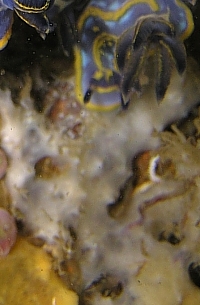
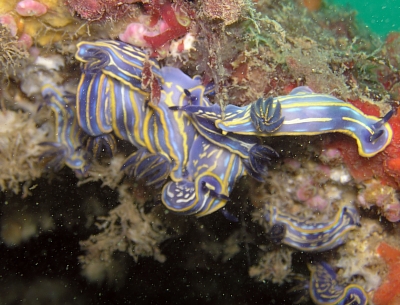
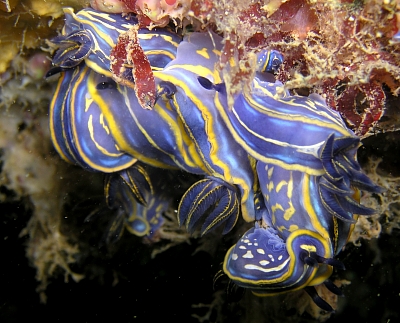
Dear David,
I think these are all Hypselodoris fontandraui. If I am right, then your photos are a very valuable example of colour variability in the species, shown perhaps most notably in the change in colour from yellow to white of the dorsal midline and its tendency to become a double line in a couple of cases.
When you see a cluster of nudibranchs together like this, you can be fairly certain that the attraction is food. It may lead to mating, because they are in close proximity, but the initial trigger for the 'togetherness' is their attraction to their food sponge. This species is reported to eat Dysidea avara [see message #5338] which is usually pink, but the greyish white sponge [see close-up] which they seem to be attracted to, looks like a Dysidea and could well be Dysidea fragilis or a colour form of D. avara.
Although this may seem 'strange behaviour', it is always a good indicator of feeding. You can always check by gently lifting an animal by its 'tail'. If it is feeding it will either be attached by its everted buccal bulb at the head end, or you will see the buccal bulb partly everted from the mouth. It is always possible that you will have more than one species together on a sponge, but in my experience, tight clusters like this are inevitably single species clusters. So this is a valuable record, because apart from confirming its food sponge, it gives us a good selection of the colour variety in the species.
Best wishes,
Bill Rudman
Re: Hypselodoris fontandraui from Cannes
June 14, 2006
From: Dominique Horst
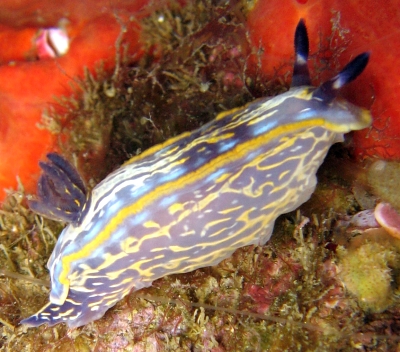
Concerning message #16769:
Dear Bill,
as usual, thanks for the time you've spent in replying messages, and thanks for your tips about how to use the Forum.
To answer one of your previous message [#16807 ], I better understand the role of colors and drawings in the identification.
Locality: Cannes, 30 m, France, Mediterranean sea, 15 May 2006, rocks. Length: 80 mm. Photographer: Eric Poisson.
My first idea about the identification of the following specimen was H. picta (picture was taken by a friend of mine). But checking anatomical external details, I'm thinking more about Hypselodoris fontandraui: The blue pigment intensity is in fact different than on previous picture I've sent, but drawings and rhinophores are fitting more with H.fontandraui even if gills are more like H. picta...
Am I right this time...?
Thanks for you patience,
Kind regards,
Dominique
dominique.horst@wanadoo.fr
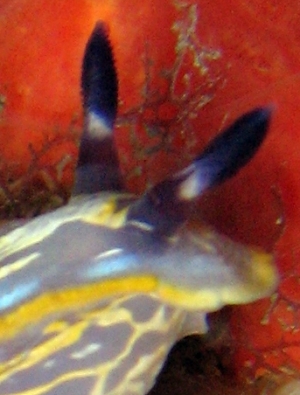
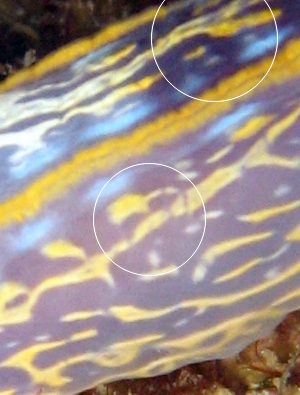
Dear Dominique,
I think you are right with Hypselodoris fontandraui. Although these 'blue chromodorids' are all very similar in colour, if you are lucky there will a few small fatures which are 'unique' to a particular species. I am by no means an expert on these Mediterranean species but two features which seem to be unique to H. fontandraui are the white patch at the posterior base of the rhinophores, and the yellow patches attached at an angle to the median line on the mantle - which is often repeated on the side of the body. Hypselodoris picta, on the other hand, always seems to have a dark blue or dark purple rhinophore club, with a yellow edge to the rhinophore sheath.
Best wishes,
Bill Rudman
Re: Hypselodoris fontandraui from Cannes
June 3, 2006
From: Dominique Horst
Concerning message #16751:
Hello Bill,
I've simply did not see it !
I surely have to improve my observations to check about the important features. But, thanks to your help, I will make progress, that's for sure.
So, about the simple gills and the branched gills - would it be a feature that determine two different species ?
What can be considered an abnormal form, as compared to the standard of the species and what can be a feature that can make the distinction on two different species. Sorry if this question is stupid, but for a novice...
Many thanks in advance,
Dominique
dominique.horst@wanadoo.fr
Horst, D., 2006 (Jun 3) Re: Hypselodoris fontandraui from Cannes. [Message in] Sea Slug Forum. Australian Museum, Sydney. Available from http://www.seaslugforum.net/find/16769Dear Dominique,
Firstly the regular branching of the gills is very strange. Some species of chromodorids [Hypselodoris, Chromodoris, Glossodoris etc], can have some irregular branches, when they are very large, but not like this. Other dorids always have branching gills, but again, nothing like this. It is such an unusual and repetitive design that I suspect it is the result of some developmental fault - but that's just a guess on my part.
Your question about how we define species is certainly not stupid, in fact it is a very good question. In the 19th century, species were often defined on very flimsy grounds - an extra spot here, a slightly longer nose there - and basically species were what the 'expert' said they were. In the 20th century, with the rise of genetics, there were many debates over how to define species, usually centred around a population of interbreeding animals, and now with the ability to relatively easily extract and uncode DNA, I guess the aim is to distinguish species by coding their DNA.
Of course as the whole mechanism of evolution is based on natural selection - that is each individual is slightly different from all others - there is always going to be this problem of just what differences define species and what differences are just part of the natural variation found within one species.
In reality, there are too few scientists working on animal taxonomy to address all these problems for every species we find, so our decisions on what is a species is usually a compromise between what is practical and what is the ideal. In most cases we try to work with a whole set of characters. It is not sensible to separate two animals as separate species if the difference is two black spots compared with five black spots on the rhinophores. Foe example, it would be good to have a number of internal anatomical differences, a few differences in shape, and some colour differences. I might give you the wrong idea when I say on the Forum that two species are different because one has a red spot on the rhinophore and another doesn't. While this may be so, there are usually anatomical differences as well which I don't mention. What I aim to do is give you some good external characters to use. After all, if the only way an ecologist could identify his subject matter was to dissect every animal, it would leave them nothing alive to study.
In brief, there is no hard and fast rule, sometimes we can't separate two species with any great confidence just by colour pattern, but thankfully we can with most, but only after we have had a look at their internal anatomy.
Best wishes,
Bill Rudman
Hypselodoris fontandraui from Cannes
June 2, 2006
From: Dominique Horst
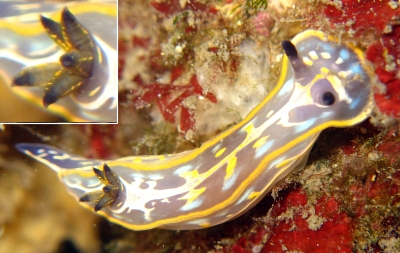
Hello,
One more request for an id. I first thought this was Hypselodoris fontandraui. But looking in your species list I have some doubt, as the blue of it's mantle is not dark blue like on the picture...
But all others details seems to confirm.
Locality: Cannes, 35m, France, Mediterranean sea, 26 May 2006, rocks. Length: 50mm. Photographer: Dominique Horst.
Any suggestion will be very appreciate.
Many thanks in advance.
Kind regards,
Dominique
dominique.horst@wanadoo.fr
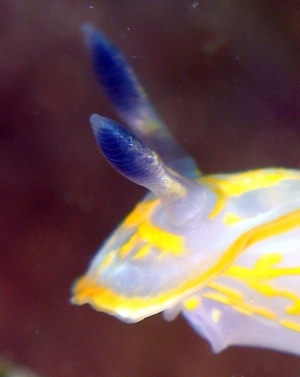
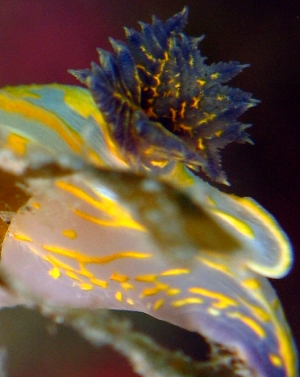
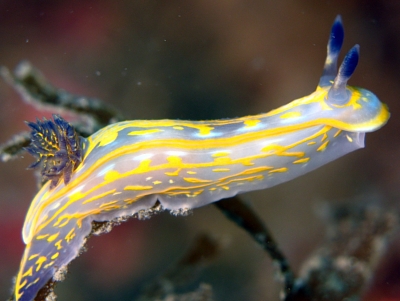
Dear Dominique,
Yes these two animals are H. fontandraui. I often say that the colour pattern is often more important than the actual colour. In this case the background can vary from pale to darker blue. Distinctive things to look out for - but they are not always all present - are the irregular yellow marks attached to the median line and the yellow marks on the base of the rhinophores.
One interesting feature in the second animal [in the photo alongside] is that each gill has small gills branching off it like a fern frond. If you compare that with the typical gills in the upper photo, you will see it is quite different. When I saw your photo I remembered seeing a similar photo once before. Have a look at Erwin Köhler's message [#5165] of another specimen of the same species with the same branched gills. It is either an unusual coincidence or perhaps something this species does as it gets larger.
Best wishes,
Bill Rudman
Hypselodoris fontandraui from Mediterranean Spain
October 27, 2005
From: David Shepherd
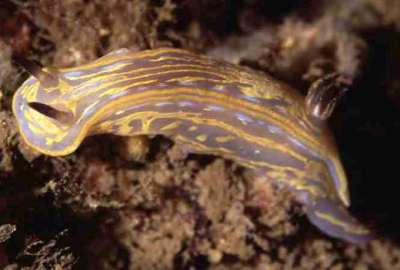
Hello again,
Yet another nudibranch that has no name in my photo collection. Can you name it for me?
Locality: Medes Isles, L'Estartit. Costa Brava, Spain. Mediterranean Sea.
Depth: 42 m, water temp.15c. Length: 12 cm. 17th August 2003. cliff wall near some gorgonians Photographer: David Shepherd
Thankyou,
David Shepherd
daveshepherd562@tiscali.co.uk
Shepherd, D.R., 2005 (Oct 27) Hypselodoris fontandraui from Mediterranean Spain. [Message in] Sea Slug Forum. Australian Museum, Sydney. Available from http://www.seaslugforum.net/find/15100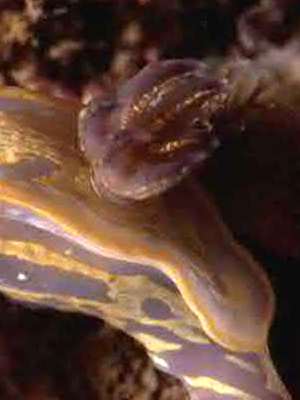
Dear Dave,
I am pretty sure this is Hypselodoris fontandraui, with the proviso that the Mediterranean blue chromodorids are quite difficult to distinguish from one another and I have little personal knowledge of them alive.
Best wishes,
Bill Rudman
Hypselodoris fontandraui from France
July 20, 2002
From: Marina Poddubetskaia
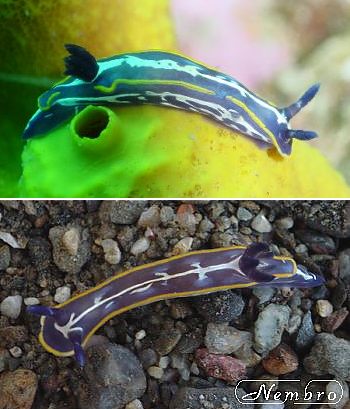
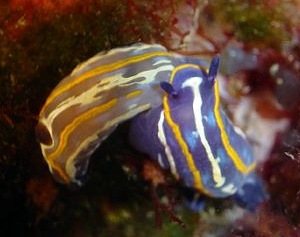
Dear Bill,
Here are some photos of Hypselodoris fontandraui. According to Jean-Pierre Bielecki (who managed the 'Sea Slugs Training Course' in Cerbere, Mediterranean coast of France, last week), there are some characteristics which distinguish Hypselodoris fontandraui from other blue dorids:
• the dorsal central line extends beyond rhinophores and finishes in a 'T'
• presence of white line pattern on foot sides
UPPER & MIDDLE: Port-Bou, France, July 03, 2002. Site: Pointe aux girelles
Depth: 5m, Size: about 3cm
LOWER: Cerbere, France, July 02, 2002. Site: Cap Negre, Size: about 3cm
Photos: Marina Poddubetskaia - Nembro website
Best wishes,
Marina.
nembro@nembro.info
Poddubetskaia, M., 2002 (Jul 20) Hypselodoris fontandraui from France. [Message in] Sea Slug Forum. Australian Museum, Sydney. Available from http://www.seaslugforum.net/find/7494Thanks Marina,
Bill Rudman
Hypselodoris fontandraui from southern Spain
October 26, 2001
From: Luis Sánchez Tocino
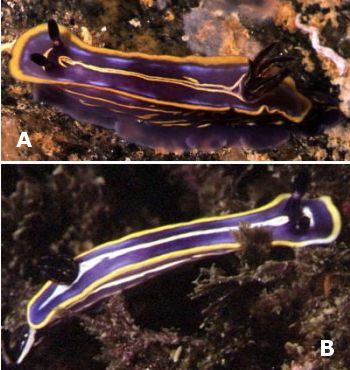
Dear Dr. Rudman
Hera are some photos of Hypselodoris fontandraui from the Granada Coast of Spain, Mediterranean Sea.
A. size 35 mm; depth 11 m; Punta de la Mona (Almuñécar) Granada. 29 April 1998
B. size 25 mm; depth 10 m; Cantarriján (Almuñecar) Granada. 15 May 1998
C. size 20 mm; Depth 10 m; Punta del Vapor (Almuñecar) Granada. 23 January 1999
D. size 30 mm; depth 11 m; (Almuñecar) Granada. 29 April 1998
In a second message there are some close-up photos showing particular parts of the animal.
Luis
lstocino@ugr.es


Dear Luis,
Thank you very much for these photos. I wish my Spanish was good enough for me to use Ortea, Valdés & García-Gómez (1996) to work out some of the key characters you use to separate these blue species.
All I know for certain is that this species is said to completely lack mantle glands. They are indeed a fascinating group.
Best wishes,
Bill Rudman
More photos of Hypselodoris fontandraui
October 26, 2001
From: Luis Sánchez Tocino
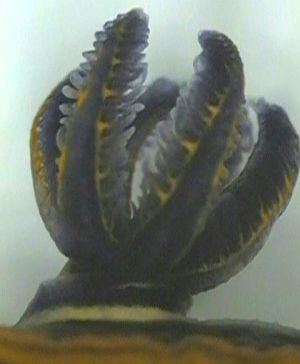
Dear Dr. Rudman
To accompany my earlier message, here are some more photos of Hypselodoris fountandraui from the Granada Coast of Spain. These are close-ups to shows the detailed colour pattern of various body parts.
Best wishes,
Luis
lstocino@ugr.es
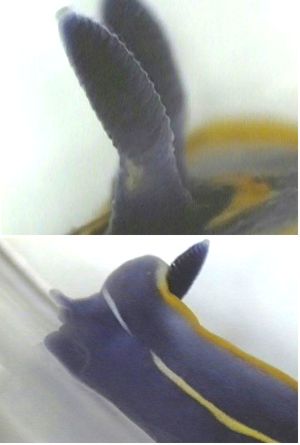
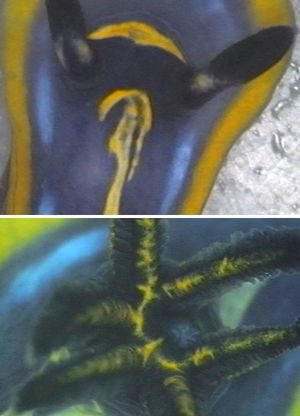
Thanks Luis,
Bill Rudman
Hypselodoris? from southern France
October 6, 2001
From: Erwin Köhler
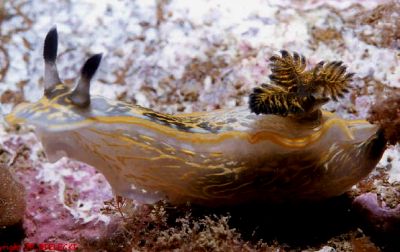
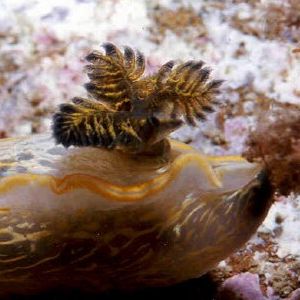
Dear Bill,
The attached one has been recently identified
by Gery Parent (France) by studies of the radula as Hypselodoris fontandraui, but I still have my doubts...I can find NO Hypselodoris with gills like that on the web (the English term is missing, is it branched gills?)
The shot is by Jean-Pierre Bielecki from Sthn France, size ~ 5 cm, depth 21m, July 2000.
I had IDed this one as Hypselodoris cf. villafranca, but with doubts, if this genus (!) is right.
Erwin
Erwin@medslugs.de
Köhler, E., 2001 (Oct 6) Hypselodoris? from southern France. [Message in] Sea Slug Forum. Australian Museum, Sydney. Available from http://www.seaslugforum.net/find/5165Dear Erwin,
I can understand your doubts. Apart from the gills, it certainly looks like a species of Hypselodoris and in external colouration it fits the descriptions and illustrations in Ortea, Valdes & Garcia-Gomez very well. One other possibility would be H. picta but the radular morphology of the two species is rather different so if Gery Parent has had a look at the radula and decided it looks like H. fontandraui I am happy to accept that.
Now about the gills. Chromodorids usually have what I have called 'simple' gills, which basically means there is no branching. In a few cases irregular secondary branches can occur, but it is not usual for any species. In most other dorids, the gills are usually tripinnate which means they have secondary and tertiary branches on the gills. In this animal the gills are showing a regular pattern of secondary branching. I have no explanation for this, but think it is a developmental anomaly in this animal rather than evidence of a strange evolutionary off-shoot.
Best wishes,
Bill Rudman
